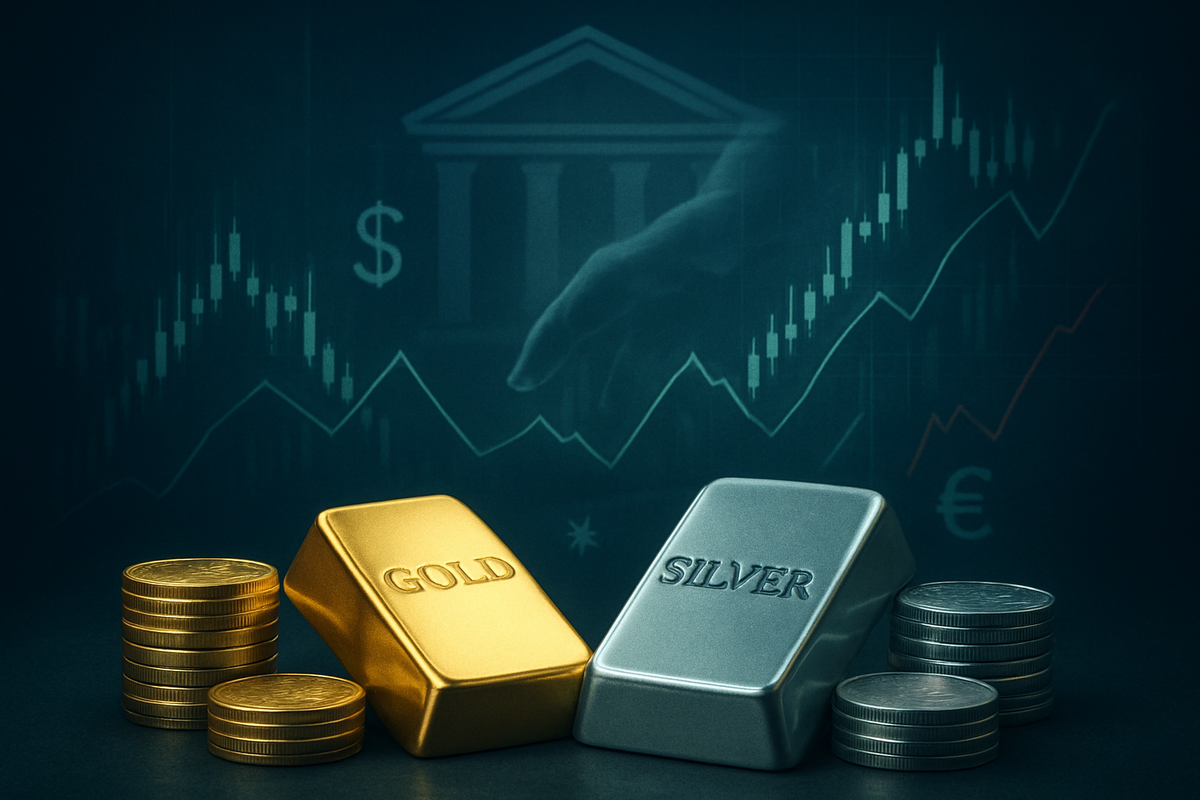
The intricate dance between central bank monetary policy and the valuation of precious metals, particularly gold and silver, remains a cornerstone of financial market analysis. As central banks worldwide calibrate their economic levers, most notably interest rates, the ripple effects invariably touch the non-yielding assets that have historically served as safe havens and inflation hedges. Understanding this dynamic is crucial for investors navigating the complexities of the global financial landscape.
At its core, the relationship hinges on the opportunity cost of holding gold and silver. When central banks, like the U.S. Federal Reserve, opt to raise interest rates, the appeal of interest-bearing assets such as bonds and savings accounts increases. This shift often diverts capital away from precious metals, which offer no yield, thereby exerting downward pressure on their prices. Conversely, a low-interest-rate environment diminishes the attractiveness of traditional fixed-income investments, making gold and silver relatively more appealing as alternative stores of value. This delicate balance is further complicated by the metals' dual role as a hedge against both economic uncertainty and inflationary pressures, both of which are heavily influenced by central bank directives.
Detailed Coverage: Central Bank Maneuvers and Precious Metal Reactions
The influence of central bank monetary policy on gold and silver is not merely theoretical; it is consistently demonstrated through market reactions to key policy decisions and economic outlooks. Historically, periods of aggressive monetary easing or tightening have provided clear illustrations of this dynamic.
Consider the aftermath of the 2008 global financial crisis. Central banks worldwide embarked on unprecedented quantitative easing (QE) programs and slashed interest rates to near-zero levels. This era of expansive monetary policy, characterized by vast injections of liquidity into the financial system, significantly lowered the opportunity cost of holding gold and silver. Moreover, the inherent economic uncertainty and fears of currency debasement fueled demand for these precious metals as safe havens and inflation hedges. Consequently, gold prices surged, reaching an all-time high above $1,900 per ounce by 2011. Similarly, during the initial phases of the COVID-19 pandemic in 2020, central banks again resorted to aggressive rate cuts and asset purchases, leading to another robust rally in both gold and silver as investors sought refuge from economic turmoil.
Conversely, periods of monetary tightening have often seen precious metals struggle. For instance, the Federal Reserve's rate hike cycle between 2015 and 2018, albeit gradual, created headwinds for gold and silver. As interest rates climbed, the attractiveness of yielding assets increased, and the U.S. dollar strengthened, making dollar-denominated gold more expensive for international buyers. More recently, the aggressive interest rate hikes initiated in 2022 to combat surging inflation initially put significant pressure on gold prices, as real interest rates turned positive and the dollar soared. However, persistent geopolitical risks and lingering inflation concerns have provided some underlying support, demonstrating that the relationship is multifaceted and influenced by a confluence of factors beyond just interest rates. Key players in these decisions include central banks like the U.S. Federal Reserve, the European Central Bank (ECB), and the Bank of Japan (BOJ), whose policy statements and rate decisions are meticulously scrutinized by the markets.
Winners and Losers: Corporate Impacts in a Shifting Monetary Landscape
The ebb and flow of gold and silver prices, driven by central bank policies, directly translates into significant financial implications for public companies operating within the precious metals sector. These companies, ranging from large-scale miners to specialized exchange-traded funds (ETFs), experience varying degrees of impact depending on their operational structures, hedging strategies, and exposure to price fluctuations.
Mining companies, such as Barrick Gold Corp. (NYSE: GOLD) and Newmont Corporation (NYSE: NEM), are often the most directly affected. When gold and silver prices rise due due to accommodative monetary policies, these companies typically see an expansion in their profit margins, as their cost of extraction remains relatively stable while their revenue per ounce increases. This can lead to higher stock valuations, increased exploration budgets, and potentially greater shareholder returns through dividends or buybacks. Conversely, a sustained period of rising interest rates and falling precious metal prices can squeeze margins, reduce profitability, and force companies to cut costs, defer capital expenditures, or even divest non-core assets. Junior mining companies, with higher operational leverage and less diversified portfolios, tend to be particularly vulnerable to downward price movements.
Beyond miners, companies involved in refining, fabrication, and even retail of precious metals also feel the effects. Furthermore, investment vehicles like the SPDR Gold Shares (NYSEARCA: GLD) and iShares Silver Trust (NYSEARCA: SLV), which aim to track the price of gold and silver, directly reflect the market's response to monetary policy shifts. Investors holding these ETFs see their portfolios appreciate or depreciate in tandem with the underlying metal prices. Financial institutions that lend to mining companies or offer precious metals trading services may also experience indirect impacts, with loan performance and trading volumes fluctuating with market sentiment. Overall, a dovish central bank stance often creates a more favorable operating environment for the precious metals industry, while a hawkish stance presents significant challenges.
Broader Implications: Monetary Policy's Far-Reaching Echoes
The central bank's influence on gold and silver valuations extends far beyond the immediate financial performance of related companies, weaving into broader industry trends, regulatory landscapes, and even global economic stability. This influence underscores the critical role monetary policy plays in shaping investor behavior and capital allocation across various asset classes.
One significant broader implication is the shifting perception of gold and silver as alternative investments. In an environment of negative real interest rates—where inflation outpaces nominal interest rates—the appeal of non-yielding assets like precious metals as a store of value is greatly enhanced. This often prompts a rotation of capital from traditional fixed-income investments into commodities, including gold and silver, as investors seek to preserve purchasing power. This trend can also influence the broader commodities market, as precious metals often act as a leading indicator for inflationary pressures or economic uncertainty. Regulatory bodies, while not directly setting precious metal prices, monitor these markets for signs of excessive speculation or market manipulation, especially given their safe-haven status during crises. Central banks themselves are also key players, often holding gold as a reserve asset to diversify their portfolios and hedge against currency fluctuations. Their buying and selling activities, driven by their own strategic monetary objectives, can significantly impact global supply and demand dynamics. Historically, periods of significant geopolitical tension or financial instability have often seen central banks increase their gold reserves, further solidifying the metal's role as a bedrock asset.
The Road Ahead: Navigating Future Monetary Tides
Looking ahead from November 17, 2025, the trajectory of gold and silver valuations will remain intimately tied to the evolving narrative of central bank monetary policy. Short-term possibilities hinge on upcoming interest rate decisions, inflation data, and any shifts in central bank forward guidance. Should inflation prove more persistent than anticipated, forcing central banks to maintain a tighter monetary stance, precious metals could face continued headwinds from higher real interest rates. Conversely, any signs of an economic slowdown or a pivot towards more accommodative policies to stimulate growth could ignite a fresh rally in gold and silver as their opportunity cost decreases and safe-haven demand resurfaces.
In the long term, the structural forces influencing central bank policy will be paramount. Factors such as global debt levels, demographic shifts, and the ongoing energy transition could compel central banks to adopt policies that either favor or disfavor precious metals. Potential strategic pivots for investors and corporations alike will involve closely monitoring inflation expectations, real interest rate trends, and the strength of major global currencies, particularly the U.S. dollar. Market opportunities may emerge in periods of sustained economic uncertainty or when central banks signal a prolonged era of low rates. Challenges, however, will persist in environments of strong economic growth coupled with aggressive monetary tightening. Potential scenarios range from a sustained bull market for precious metals if inflation remains elevated and real rates stay low, to a more subdued performance if central banks successfully anchor inflation and foster robust, non-inflationary growth.
Concluding Outlook: A Golden (and Silver) Future?
The profound influence of central bank monetary policy on gold and silver valuations cannot be overstated. From the opportunity cost dictated by interest rate decisions to their roles as safe havens and inflation hedges, precious metals respond dynamically to the levers pulled by the world's leading financial authorities. The past demonstrates a clear correlation: expansive, low-interest-rate policies generally bolster gold and silver prices, while tightening cycles tend to create headwinds.
Moving forward, investors must remain acutely attuned to central bank pronouncements, particularly those from the U.S. Federal Reserve, given the dollar's global dominance in pricing these commodities. Key takeaways include understanding that real interest rates are a more significant driver than nominal rates, and that geopolitical instability can often override conventional monetary policy impacts. The market's assessment of future inflation and economic growth will continue to shape central bank actions, thereby dictating the attractiveness of gold and silver. What investors should watch for in the coming months are any shifts in central bank rhetoric, core inflation readings, and the trajectory of the U.S. dollar, all of which will provide crucial clues to the future path of these enduring precious metals.
This content is intended for informational purposes only and is not financial advice





